





 |
|||||||
 |
 |
 |
 |
 |
|||
| |
|||||||
|
Practicing What We Teach:
|
||||||||||||||||||||||||||||||||||||||||||||||||||||||||||||||||||||||||||||||||||||||||||||||||||||||
|
Artists' Toolkit Component |
|
Learning Style |
|
Watch:Short animations that demonstrate the concept using an artwork from the institutions' collections (Figure 2). |
Reflective Observation |
Diverging and Assimilating:
|
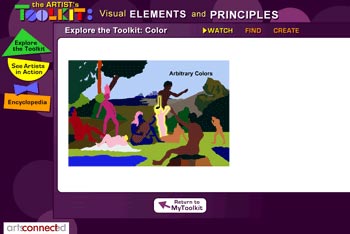 Figure 2. Watch module. www.artsconnected.org/toolkit/watch_color_arbitrary.cfm |
||
|
Find:Examine three artworks and drag labels of each concept over to instances of them in the art (Figure 3). |
Active Experimentation |
Accommodating and Converging:
|
|
|
||
|
Create: Apply the concepts in an original composition with an open-ended picture-making tool. Add lines and shapes to a canvas and arrange them to create a picture (Figure 4). |
Concrete Experience |
Accommodating and Diverging:
|
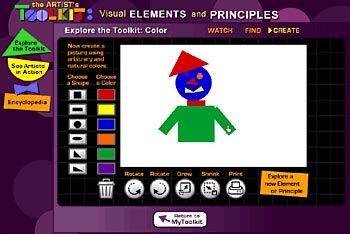 Figure 4. Create module. www.artsconnected.org/toolkit/create_color_arbitrary.cfm |
||
|
Encyclopedia: Study the concepts in more depth through expository text and example artworks (Figure 5). |
Abstract Conceptualization |
Assimilating:
|
 Figure 5. Encyclopedia module. www.artsconnected.org/toolkit/encyc_colornatural.html |
||
Table 1. The Artists' Toolkit components and targeted learning styles. The first three components above were designed for K-5 grade students; the fourth one is a didactic resource for older students and teachers.
Connecting Learning Styles and Activity Types
By examining differences in mental processing preferences, Kolb's model
also suggests ways that online activities can engage different types of
learners. We have hypothesized plausible links between Kolb's styles and
our own typology of online activities (Schaller et al., 2002) as
follows:
Role-Play activities allow users to adopt a persona different from their own, giving them the ability to do things they cannot ordinarily do (e.g. break natural or societal laws, experience people and places normally out of reach). They can also interact with other characters, whose behavior either may be scripted or controlled by other players. (True social interaction on the Web, i.e. direct communication with other people, is one of its key strengths, but it also poses many challenges with a school-age audience, from privacy concerns to risks of inappropriate communication. This means that many activities that could in principle take advantage of the technology to connect real people with one another must substitute interaction with the program.) We hypothesized that the Role-Play activity type may appeal to those with a strong Accommodating learning style.
Simulation employs a model of the real world that users can manipulate to explore a system. It involves direct engagement with representations of data with some degree of generalization or abstraction. While many activities may have an underlying simulation or model that generates the activity decision tree, "simulation" as used here is explicitly framed as such in its presentation to the user, and is used to develop conceptual understanding of a complex system. We hypothesized that this activity type may appeal more strongly to people with either an Assimilating or Converging learning style.
Puzzle/Mystery involves analysis and deductive or inductive reasoning to reach a logical solution. The user relies on evidence from people, nature, or reference material provided by the activity to solve the problem. We hypothesized that this activity type may be more appealing to people with either an Assimilating or Converging learning style.
Creative Production emphasizes both open-ended self-expression and the application of subject knowledge and concepts to building some kind of product such as a story, a picture, a movie, etc. We hypothesized that this activity type may appeal more often than the other types to the Divergent learning style.
With these associations in mind, we sought to offer a variety of learning experiences in a suite of educational web activities, Shedd Educational Adventures (SEA) (www.sheddaquarium.org/sea), developed in partnership with the John. G. Shedd Aquarium. We should emphasize that we do not see each activity type appealing solely to a single learning style. Rather, different learners will utilize each type of activity differently. As developers, recognizing the strengths of each activity type and the learners it appeals to most strongly helps us avoid building activities that appeal merely to our own learning styles.
Squish the Fish (Figure 6) is an interactive role-play story for primary-grade children (grades K-2). Although users do not explicitly assume the role of Squish, they guide him through a dangerous journey across a coral reef. Squish has the ability to shape-shift and color-shift to avoid predators, and users can vicariously go along for the ride. While experiencing no social interaction with other people in real time, users do meet a variety of talking fish and other undersea creatures that personify the various adaptations that Squish uses to stay alive, thus attempting to engage Accommodating learners.
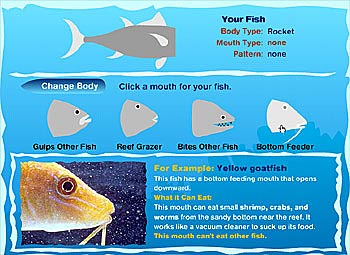 Figure 7. Mouth-types choice screen from Build-a-Fish. www.sheddaquarium.org/SEA/interactive_module.cfm?id=7 |
Build-a-Fish (Figure 7) is a simulation with a touch of creative
production, intended for upper primary students (grades 3-5). Players
design a fish and then navigate it around a detailed coral reef, trying
to eat other fish and avoid being eaten in turn. This pragmatic challenge
engages Convergent Learners, while Assimilating Learners can review didactic
content to inform their hypotheses of which fish designs will be most
successful.
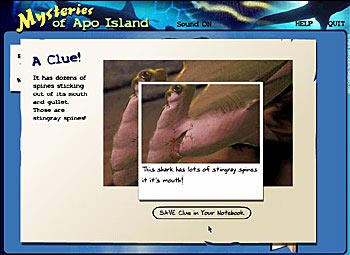 Figure 9. Clue screen from Mysteries of Apo Island. www.sheddaquarium.org/SEA/interactive_module.cfm?id=9 |
Mysteries of Apo Island (Figure 8) is designed for middle school students (grades 6-8), and offers clues that the user must analyze and synthesize to solve a series of mysteries. While exploring a map of Apo Island in the Philippines, users encounter stories and personal observations of strange animal behavior. Each of these can be collected in the user's notebook, where they can then compare the clues and sort them into groups by species. In this way the activity is an "open-ended mystery." While the clues do match up to correct solutions, users are not funneled toward solutions, as they would be in a branching story structure. Instead, users must use logical deduction to hypothesize solutions and then ask a local biologist to check their conclusions.
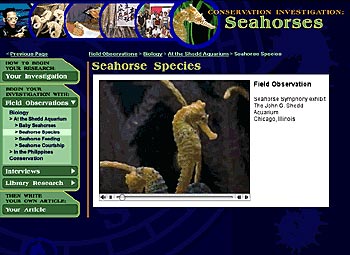 Figure 9. Seahorse video clip from Conservation Investigation: Seahorses. www.sheddaquarium.org/SEA/interactive_module.cfm?id=11 |
We initially planned to develop a simulation for the high school audience (grades 9-10). But due to conceptual issues (detailed below) and budgetary constraints, we turned instead to an interactive reference module. In Conservation Investigation: Seahorses (Figure 9), students can explore a conservation issue through primary and secondary sources and write a newspaper editorial based on their research. The student assumes the role of an investigative reporter and is offered a range of materials about seahorse conservation grouped according to how a journalist might research the story: field observations, interviews, and library materials. In writing their final product, the student is guided by a template that encourages logical organization and solid evidence to support their opinion. This combines role-play and creative production elements, but in a less fanciful, more serious fashion for this more mature age group.
Integrating Learning Styles into One Activity
One of the challenges of using Kolb's framework is that while it is clear
how to match a particular learning style with a particular activity type,
Kolb offers less guidance in creating a single activity that can meet
the needs of learners with multiple learning styles. Howard Gardner's
theory of multiple intelligences has earned wide acclaim and regard from
both formal and informal educators. By examining many cognitive modalities,
his theory inspires us to stretch the Web's capabilities to engage many
different kinds of learners. Table 2 shows how Gardner's Entry Point Approach
outlines ways to provide multiple entry points to a single learning experience
"to accommodate the different lenses through which learners see"
(Davis and Gardner, 1993).
|
Entry Point |
Learners respond to: |
|
Narrative: |
The story. |
|
Numerical: |
Numbers, statistics, and mathematical models, as well as musical rhythm. |
|
Logical: |
Logical propositions, syllogisms, narrative plot structure and cause and effect relationships. |
|
Existential/Foundational: |
Big questions about life, death and our place in the world. |
|
Aesthetic: |
Surface qualities of art and music, as well as other subjects, i.e. balance in an ecosystem, harmony in the built environment, etc. |
|
Hands-on or Experiential: |
Direct exploration, both physical and virtual, through experimentation, creativity, and immersive experiences. |
|
Interpersonal: |
Social interaction through cooperation, debate, and role-play. |
Several researchers have explored these entry points in the museum context. Project Explore examined which entry points children and adults utilized at several children's museums, and found that Experiential was by far the most common, with Narrative a distant second and the rest even less frequently evoked (Please Touch Museum and Project Zero, 1998). Experiential is, of course, the easiest entry point to observe in a museum setting. But even in an exhibit with musical instruments, the Aesthetic entry point was rarely observed. The researchers concluded that this disparity may stem from either methodological issues or deeper questions of exhibit design or even young children's cognition.
For Shedd's SEA package, we considered how to design each online activity to contain multiple entry points (Table 3).
|
Activity |
Entry Points |
How users might engage entry points |
|
Squish the Fish |
Narrative |
Responds to Squish's quest to travel across the reef to eat and to return home again. |
|
Aesthetic |
Comparing examples of shape, color, and pattern adaptations.Reading the rhyming verse. |
|
|
Hands-on/ Experiential |
Trying an adaptation and seeing whether it protects Squish from Big Tooth Blob. |
|
|
Logical |
Systematically testing each adaptation on various places on the reef. |
|
|
Build-a-Fish |
Hands-on/ Experiential |
Designing a fish and seeing whether it can eat and avoid being eaten on the reef. |
|
Logical |
Systematically testing fish designs to see which does best in various places on the reef. |
|
|
Aesthetic |
Considering shape and color differences in design options while designing fish. |
|
|
Mysteries of Apo Island |
Narrative |
Responds to the story setup. |
|
Logical |
Examining and comparing clues, identifying shared characteristics
of clues. |
|
|
Hands-on/ Experiential |
Exploring the island map, sorting clues into groups. |
|
|
Conservation Investigation: Seahorses |
Narrative |
Responding to journalist story framework. |
|
Logical |
Recording, reviewing and analyzing research information and synthesizing into article. |
|
|
Interpersonal |
Observing video clips of seahorses and interviews with biologists. |
Table 3. Connections between Entry Points and Shedd SEA activities.
During pilot testing, naturalistically observed student behavior suggested that the entry points we intended for the activities were in fact used:
Squish. The target audience responded enthusiastically to the Narrative framework of Squish.
Build-a-Fish. Younger students (3rd grade) typically used the Hands-on entry point, experimenting with fish designs without logically considering the causes and effects of each choice. Middle school students, however, usually did prefer the Logical entry point and were often quite methodical in testing each combination of fish design options. Aesthetic engagement was seen in requests for a larger variety of fish body parts and colors to choose from. Further evaluation is required to determine whether the game was simply too challenging for third graders to use more logical approaches without teacher guidance or if children favor different learning styles at different developmental stages.
Mysteries of Apo Island. Middle school students responded well to the Narrative entry point, sometimes making up their own scenarios about why a shark might behave in a way consistent with the clues. As is discussed below, younger middle school students had trouble with the Logical aspects of the activity, and frequently were unable to develop the chain of inference that would let them solve the mystery.
Conservation Investigation: Seahorses. Teachers evaluating this activity felt that the Logical guidance offered in structuring the research and writing exercise would be helpful and appropriate for this age level.
Kinds of Understanding
As noted above, current learning theory holds that learning involves a
transformation of mental schemas, from flawed and incomplete to truer
and more complete (Bransford et al. 2000). To facilitate such
transformations most effectively, educators must understand their students'
prior knowledge, experiences, and most critically, their misconceptions,
about the subject. Only by tackling such misconceptions directly can educators
effectively help learners to overcome them and achieve a truer (more accurate)
understanding of the world (Borun 1990, Hein 1998). Much of our knowledge
of such misconceptions derives from Piaget's research. Indeed, much of
contemporary learning theory is based on his work, which mainly investigated
children's learning about the physical world and mathematics (Egan 1998).
In such domains, hands-on experimentation is invaluable as a way to bring
"students' earlier models or misconceptions into sharp focus [through]
an experience that directly challenges the viability of the model they
have been favoring" (Gardner 1991). Exploring a parallel phenomenon
in the humanities, Gardner discusses the persistence of stereotypes, scripts
and simplifications such as "the 'bad man' theory" of history,
even among well-educated college students (Ibid.). To transform
such misconceptions, a strict constructivist approach would start with
familiar and concrete objects and places before moving to the distant
and abstract.
A teacher can discover her students' misconceptions and stereotypes from a class discussion at the start of a lesson. Similarly, museums conduct front-end research studies to ascertain their audiences' pre-existing knowledge and misconceptions and stereotypes (also called preconceptions and naive notions) about a program or exhibit topic. This task is challenging enough when exhibits attract visitors of many ages and experiences. On the Web, which attracts learners of all ages in varying settings from around the globe, trying to determine pre-existing knowledge and misconceptions is even more daunting. When learning theory calls for an emphasis on what is familiar to learners, the challenge becomes difficult indeed.
Educational theorist Kieran Egan offers a way out of this dilemma by re-imagining what kinds of knowledge come naturally to learners at each stage of development (Egan 1988, 1992, 1998). He argues that our powerful imaginative capacities are much more effective (and affective) avenues to learning than the prosaic approaches advocated by Piaget's strictest adherents. Even young children have a deep (if difficult to articulate) understanding of certain profound abstract concepts such as good/bad, beauty/ugliness and survival/destruction. Medieval fairy tales and the Star Wars movies would have little hold on children if this were not the case. These abstractions have deep affective meaning for children (and adults) and thus are very powerful ways to present new material.
|
Kinds of Understanding |
Age |
Concerns |
Examples |
|
Somatic |
Birth to three |
Body abilities |
Walking |
|
Mythic |
Three to eight |
Binary opposites |
Star Wars movies |
|
Romantic |
Eight to fifteen |
Limits of reality and experience; heroes, idealism |
Guinness Book of World Records Michael Jordan "Save the Earth" |
|
Philosophic* |
Fifteen to twenty |
Systems and schema |
Marxism |
|
Ironic* |
Twenty and up |
Self-reflective |
Post-modernism |
*While the first three phases occur fairly naturally in human development, the latter two require substantial guidance and support for an individual to achieve.
Table 4. Egan's theory of developmental phases in learning style (Egan 1998).
Each new kind of understanding builds on previous stages. As young children, we begin to organize the world by dividing everything into binary opposites. Only after we have created basic categories can we start to refine our mental organization of the world, typically by exploring the extremes of reality (from the tallest human to a hero who transcends limitations and adversity) to better understand our own place within this order. It is after gaining a sense of the range and variety of experiences that we start thinking about how they all relate to one another. The philosophic level propels the search for causal connections that have birthed theories from Marxism to the second gunman on the grassy knoll. Acquiring the ability to construct such general schema can trigger a period as a "true believer" with tunnel vision, but with some outside support, we can ultimately achieve Ironic understanding, or a deep appreciation that every theory contains some truth but none can claim to be The Truth. This doesn't mean that adults who have reached this phase can't enjoy an occasional Star Wars movie, for the "simplistic" theme of good vs. evil still resonates deep within us, but that we can appreciate it for what it is without then interpreting real international affairs through the same lens.
What Egan's theory offers us as designers of online learning experiences is valuable guidance about the kinds of abstractions people will find innately relevant and meaningful. We were inspired by these ideas during the development of the Shedd Educational Adventures online activities with the Shedd Aquarium. Since this project entailed producing online learning modules for five grade groups: K-2, 3-5, 6-8, 9-10, and 11-12, we kept Egan's kinds of understanding in mind during our development process, letting them inform the themes we developed and the stories we told.
Mythic Understanding and Squish the Fish
The learning goals for elementary grade activities centered on fish adaptations
and easily lent themselves to stories of danger and survival. Squish the
Fish and Big Tooth Blob, cartoon characters from Shedd's existing education
materials, embody the struggle for survival which children so easily grasp.
Squish must travel across the reef, looking for friends who have successful
shape, color and behavioral adaptations to protect themselves from Big
Tooth Blob. Children instinctively understand the binary opposites of
safety and danger and this, rather than any reference to the concrete
world of our child-audience, is the theme that carries the message.
Amplifying the safety-danger theme meant making Big Tooth Blob a pure predator with no sympathetic traits. However, since his name and appearance are more comical than threatening, he is portrayed as simply hungry, rather than as menacing or malevolent. Thus no one clamored to give Big Tooth's side of the story. With a subject such as history, resistance to binary stereotyping from either the target audience or in the eyes of teachers and subject experts would pose more problems.
The real question is whether the story is mythic enough. Using the term in a similar way, Rounds (2002) describes the tension between mythic and scientific thinking, arguing that museum visitors often interpret science content in mythic terms. The factual content is not what interests them. It is the meaning they can make from the stories that is important, and they judge those stories by their affective authenticity, not by their factual accuracy. The mythical aspect of the safety-danger theme in Squish gives the story some degree of affective authenticity, but our real goal centered on communicating the factual content about various organisms and their adaptations. Squish succeeds because it offers a scientifically credible mythic framework for the more abstract and emotionally neutral concept of adaptation as an evolutionary response to survival and predation. We want to emphasize that deploying a mythic theme that does not naturally stem from the content in an activity such as this will only undermine its educational value for the learner and its credibility with the teacher.
Romantic Understanding and The Mysteries of Apo Island
The Shedd's learning goal for this activity was shark biodiversity—showcasing
"the many kinds of sharks and their fascinating adaptations and behavior."
Exploring this theme through the romantic fascination with the exotic
and bizarre ("the limits of reality and extremes of experience,"
in Egan's terms) was straightforward enough, since there are plenty of
odd shark adaptations and behaviors from which to choose. The challenge
lay in taking it beyond a "trivia quiz" approach that might
prove intriguing but would still consist of informational dead-ends. Our
goal was to design an activity that leveraged the romantic fascination
with exotica into a larger learning experience that developed synthetic
reasoning skills. For that we turned to a mystery format. The trivia were
made into clues that, if examined and integrated, provided the solutions
to the mystery. Thus we hoped to foster a romantic understanding of shark
biodiversity within a deductive reasoning process, thereby suggesting
the path ahead to philosophic understanding.
Pilot testing indicated that shark exotica were indeed successful in engaging the students' attention. Some also responded quite enthusiastically to the deductive structure of the activity, while others (especially students at the lower end of the grade 6-8 target range) enjoyed the clues but found the mystery befuddling. That kind of synthesis is more characteristic of philosophic understanding and so it shouldn't be surprising that some 12-year-olds found it too challenging.
In another example of Rounds' mythic-scientific distinction, we also found that students sometimes assumed the solution would focus on an individual shark rather than a shark species as a group. Students would spin their own stories about "a bad shark" that attacked the boat and other sharks, fantasizing many details that were quite out of character for the mystery itself. Of course, the mystery format (as well as most appearances of sharks in popular culture) encourages this interpretation. Our own scientific-mindedness had blinded us to the likelihood of this result. We have since emphasized the idea of species as groups in the activity text, but we await summative evaluation to see whether that makes any difference.
Philosophic and Ironic Understanding and an Ill-fated Simulation
Inspired by Sherry Turkle's call for "simulations that teach about
the nature of simulation itself, that teach enough about how to build
[your] own simulation that [you become] a literate 'reader' of the new
medium," we decided to tackle just such an effort (Turkle 1997).
Building on a coral reef management simulation already produced for Shedd,
we imagined letting students "under the hood" of the simulation
so they could tinker with its assumptions and parameters. We were motivated
by our own awareness that every model has both descriptive power and predictive
blind spots. We wanted students to be able explore how the hidden assumptions
and underlying logic of a model can dramatically affect the simulation's
portrayal of the real world.
However, presenting this concept to high school teachers in focus groups led us to abandon it. The teachers felt that orienting students in this age group to a model of ecosystem management, however simplified, was challenging enough. Layering additional complexity with the reflexive analysis of the model itself was more than students could handle, at least with such an unfamiliar subject. Consequently, we switched to a simpler and more traditional interactive reference format (Conservation Investigation: Seahorses), hoping to return to Turkle's challenge in the future. In retrospect, we should have heeded Egan earlier, since his notions of philosophic and ironic understanding anticipate this quandary. Philosophic understanding, as in looking for systems, schema, and underlying causes, is well suited to explicitly exploring models and simulations as such (rather than concealing the model in a mythic or romantic wrapper). But because philosophic understanding so enthusiastically embraces the search for cause and effect, there is a strong tendency at this stage to take the model at face value. The ability to step back and question the construction of the model itself truly arrives only with Ironic understanding.
Since questioning models is ultimately such an important skill, we still hope in the future to develop a simulation that facilitates this sort of meta-examination. However, it is clear that the simulation should focus on a familiar domain and be targeted at more advanced (perhaps even college-level) students. Our ecosystem management simulation tried to tackle too much and over-ambitiously tried to work on two very different levels: the issues surrounding coral reef management efforts, and the art of modeling a real world system. That is simply too much of an analytical load for high school students to handle.
Offering a simulation as an appropriate means of examining a system's function might also leverage Mythic understanding, capturing the user's interest with a dramatic binary opposition between stereotyped forces of good and evil (perhaps polluters and conservationists), then suggesting that this model does not show what's really going on and inviting them to dig under the surface of the simulation in search of the truth. In this way, users would find some initial comfort in mythic understanding while engaging in their natural philosophic quest for truth and causality. Similar approaches could easily be applied to history and other subjects where mythic stereotypes are common, but where Ironic understanding might lend a valuable level of sophistication.
Where Do We Go From Here?
The above examples indicate the potential for using learning theory to
guide thoughtful and innovative educational design on the Web. When the
Web was in its infancy as a medium, trial and error development was appropriate.
No one knew what might work, and rapid changes in the technology created
a quickly moving target. As the Web has matured, the need for more explicit
best practices and metrics for evaluating the quality and success of our
projects has become apparent. A face-to-face learning environment allows
the effective teacher to respond to subtle cues about student knowledge,
interest, and ability. We do not have that luxury online, and instead
we must attempt to formalize within the programming of the activity much
of the tacit feedback the teacher can draw upon. As we have suggested
above, a development process informed by learning theory helps embed the
teacher's expertise into an online learning experience that has no two-way
communication between real people.
Even as these case studies demonstrate the benefits of explicitly applying learning theory to online activities, they also raise questions. Can rigorous research and evaluation of online learning activities help us refine learning theory as a whole? Can we empirically demonstrate whether these ideas really do improve users' experience, or even their learning (whatever that ultimately is)? Given the present politics of public education in the United States, which emphasizes high stakes testing and demonstrating student mastery of specific standards, we do not serve our clients or their funders well if we continue to offer only impressionistic accounts of the impact of our projects. Such a promise of more objective evaluation might seem hubristic, given how difficult it is to measure the users' experience in the offline world. However, we anticipate that the same technical limitations of online learning that require us to formalize the content and learning methods will also help us to capture and analyze information that will shed light on the user experience.
Furthermore, can we continue to ignore the setting in which online activities are used, or do we have to pay closer attention to where the user is and why they are using the activity? For example, do we need more support for teachers to accompany each activity intended for classroom use? In the case of SEA, Shedd saw teacher support materials as crucial from the outset. We hope to see with further study how support materials affect the effectiveness of the SEA activities. It may be that teachers view electronic activities as by nature self-contained. Given that the Web allows access to all comers, the challenge remains to offer novice users the right entry point without assuming that they can or will use external supporting materials or guidance.
As we have surveyed learning theory, from Kolb to Gardner to Egan, and tried to make sense of our real-world products in their light, it is clear that no one theory can be our single guiding light. It seems more pragmatic to treat the range of learning theory frameworks as a developer's toolbox from which we can pick and choose according to the needs of a particular project. Given the diversity of learners and learning environments, we favor the instrumental view that we should not attempt to impose a single framework on all subject content, learning goals, use context, and institutional missions and cultures. What works for the context and content of one project may be completely unsuitable for another.
At the end of the day, our thumbnail sketch of learning theory does expose limitations in applying general theories to complex, practical problems. As we discussed above, a strong social constructivist approach to pedagogy that puts a high premium on social interaction and assessing and adjusting to student knowledge may find many current online activities lacking. At the same time, we remain optimistic that some types of online learning experiences open doors to understanding that cannot be offered in any classroom (Prensky 2001). This is not a dismissal of the classroom experience, but a recognition of the ways that computer-aided research tools have dramatically transformed the practice of many research fields, from visualization in the sciences to databases in the humanities. Much of our effort is motivated by the desire to bring these tools within reach of non-experts.
Finally, and most ambitiously, can studying online learning actually advance our understanding of learning, or merely confirm or fail to support existing principles developed for other learning arenas? As the methods and instruments for evaluating online learning mature, we expect online learning to offer a lively test bed for the continuing quest for knowing how we know.
Acknowledgements
The authors wish to thank Minda Borun, Theresa Esterlund, Eric Gyllenhaal,
Nancy Ross, and Kris Wetterlund for their insightful comments on earlier
drafts of this paper.
This paper was originally published by Achives and Museum Informatics in the proceedings of the Museums & the Web 2003 conference. © 2003 Archives and Museum Informatics.
References:
Bransford, J.D., A. L. Brown, and R.R. Cocking, eds. (2000). How People
Learn: Brain, mind, experience, and school. Washington, D.C.: National
Academy Press.
Davis, J., and Gardner, H. (1993). Open windows, open doors. Museum News. January/February 1993.
Egan, K. (1998). The Educated Mind: How cognitive tools shape our understanding. Chicago: University of Chicago Press.
Egan, K. (1992). Imagination in Teaching and Learning: The middle school years. Chicago: University of Chicago Press.
Egan, K. (1986). Teaching as Storytelling: An alternative approach to teaching and curriculum in the elementary school. Chicago: University of Chicago Press.
Gardner, H., (1991). The Unschooled Mind. New York: Basic Books.
Gardner, H., (1999). The Disciplined Mind. New York: Penguin Books.
Gyllenhaal, E. D., Beaumont, L., & Tyree, A. (2003). Formative evaluation of the On-line Teacher Resources project: Final report. Unpublished manuscript, John G. Shedd Aquarium, Chicago, IL. Available at http://www.sheddaquarium.org/SEA/research/.
Guild, P.B., and S. Garger. (1999). Marching to Different Drummers, 2nd edition. Alexandria: Association for Supervision and Curriculum Development.
Hein, G. E. (1998). Learning in the Museum. London: Routledge.
Henke, H. (1997). Applying learning theory to computer based training and web-based instruction, last updated April 16, 1997, consulted January 14, 2003, http://scis.nova.edu/~henkeh/story2.htm.
Jonassen, D.H., K.L. Peck, and B.G. Wilson. (1999). Learning with Technology: A constructivist perspective. New Jersey: Merrill.
Kolb, D. A. (1984). Experiential Learning: Experience as the source of learning and development. New Jersey: Prentice-Hall.
Kolb, D. A., R. E. Boyatzis, and C. Mainemelis. (1999). Experiential learning theory: Previous research and new directions. In R. J. Sternberg and L. F. Zhang (Eds.), Perspectives on Cognitive, Learning, and Thinking styles. NJ: Lawrence Erlbaum, 2000.
Prensky, M. (2001). Digital Game-Based Learning. New York: McGraw-Hill.
Project Zero. (2000). MUSE QUESTs (Questions for Understanding, Exploring, Seeing and Thinking). Cambridge: Harvard University.
Rounds, J. (2002). Storytelling in science exhibits. The Exhibitionist, Vol. 21, No. 2 (Fall 2002).
Schaller, D.T., S. Allison-Bunnell, M. Borun, M. Chambers. (2002). How do you like to learn? Comparing User Preferences and Visit Length of Educational Web Sites. In D. Bearman and J. Trant (Eds.), Museums & the Web 2002: Selected Papers from an International Conference. Pittsburgh: Archives and Museum Informatics.
Schank, R. (1992). Goal-Based Scenarios. Chicago: Northwestern University Institute for the Learning Sciences. Technical Report #36. Available at: http://cogprints.soton.ac.uk/documents/disk0/00/00/06/24/cog00000624-00/V11ANSEK.html
Strohkorb, J. (2002). Personal communication.
Turkle, S. (1997). Seeing Through Computers: Education in a Culture of Simulation. American Prospect, Vol. 8, Issue 31. March 1 - April 1 1997. Consulted January 14, 2003. http://www.prospect.org/print/V8/31/turkle-s.html.
Veenema, S. and H. Gardner. (1996). Multimedia and multiple intelligences. American Prospect, Vol. 7, Issue 29. November 1 - December 1 1996. Available at: http://www.prospect.org/print/V7/29/veenema-s.html.
